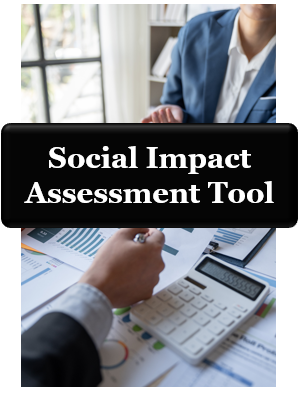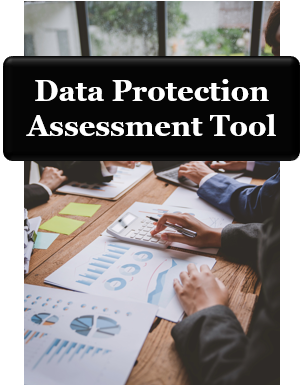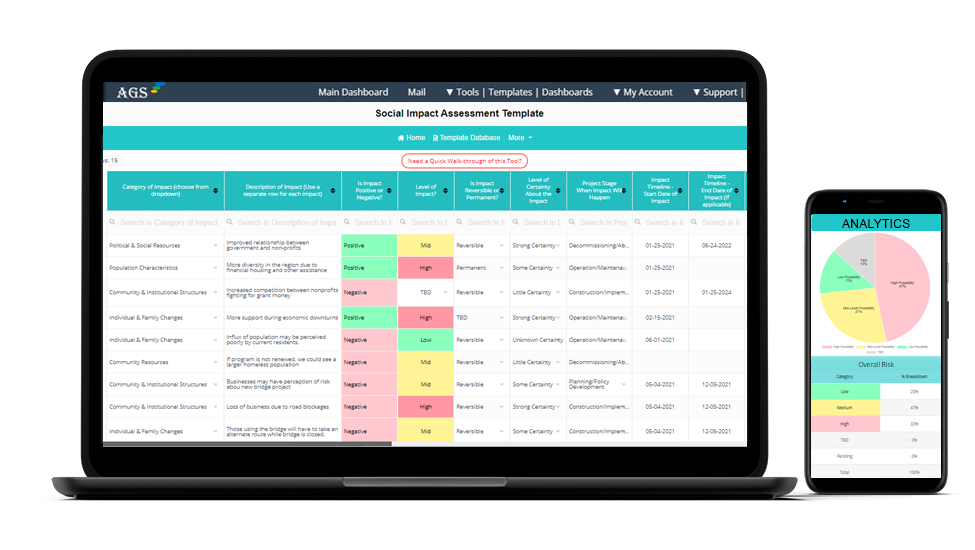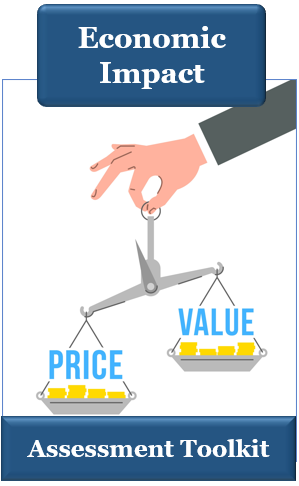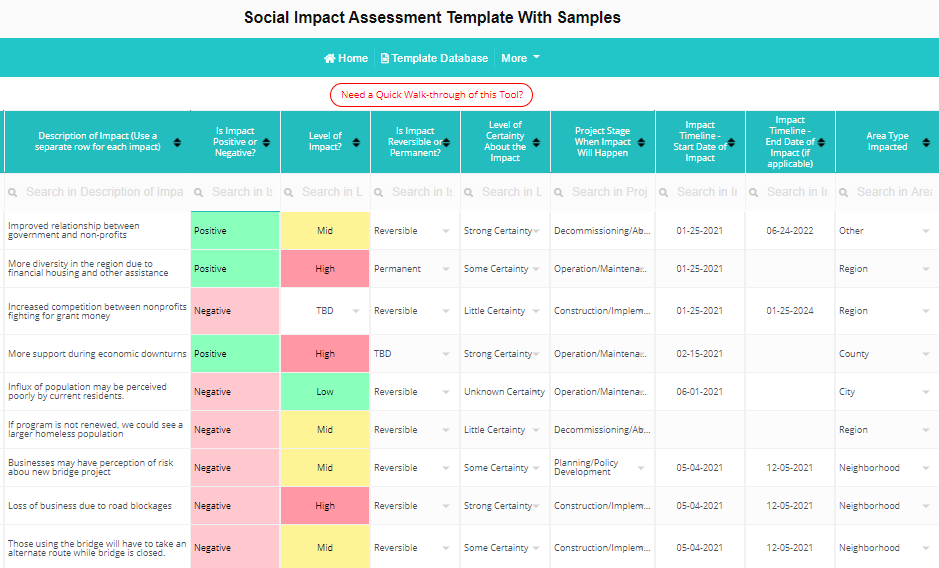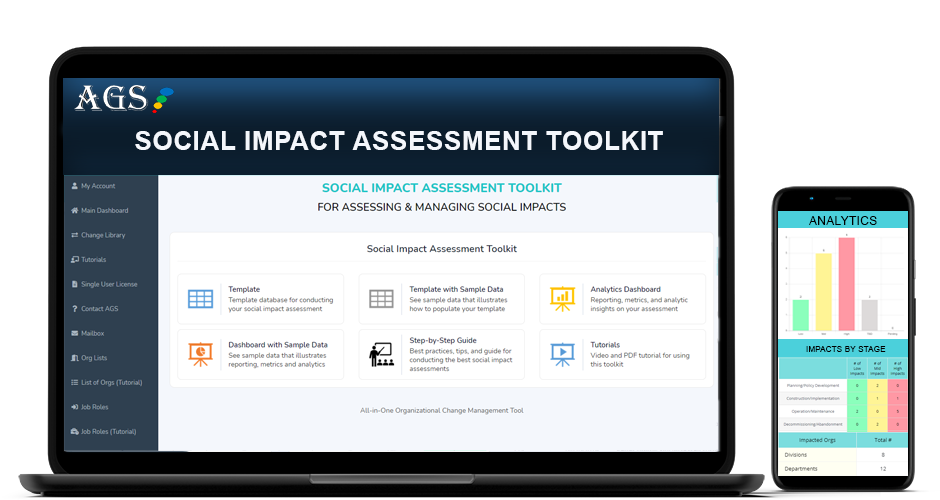COMPLETE GUIDE TO THE BEST SOCIAL IMPACTS ASSESSMENT & SIA ANALYSIS BEST PRACTICES
The Best Guide for Conducting an Effective Environmental and Social Impact Assessment! (Samples and Templates – PPT & PDF)
A vital part of planning for any new policy, program, plan, or project is to understand how that intervention will impact people and their environment.
Will a proposed change in hospital policy result in a negative health impact for a community? Will a new highway being added to a town offer more positive effects than negative for nearby retailers?
These are the types of questions that are answered through a socio-economic impact assessment.
Social impact examples can vary widely according to the type of intervention being planned. For example, a construction project can impact the environment for both humans and animals. If the planned change is policy-related, then there may be political impacts that come out in social impact assessment reports.
The social impact of road construction is going to require a certain set of variables when doing social impact analysis. A new program to grant loans in underserved areas will have an entirely different social impact meaning.

What is a Social Impact? | Social Impacts Assessment
The social impact definition will vary according to the types of changes your project, plan, program, or policy will make to a community and the daily lives of the people that live there. This makes a social impact assessment report one of the most complex of any type of impact assessment.
But it’s also one of the most important.
It’s vital to understand how an intervention is going to affect people and their environment. Without doing a social impact evaluation or an environmental social impact assessment, a project or policy could cause irreparable harm to a community or serious unintended consequences.
What You’ll Learn in This SIA Social Impact Assessment Guide
In this AGS guide on conducting an ESIA, environmental social impact assessment, we’ll go through an overview that answers questions like, “What is social impact?” and go into detail on the definition of social impact assessment and the EIA SIA process.
What you’ll find in this article:
- What does social impact mean?
- What is a social impact assessment example?
- The purpose of a social impact study
- Social impact assessment process
- Social impact assessment tools
- The meaning of social impact assessment UPSC
- Social risk assessment template
- Downloadable environmental and social impact assessment PPT
- Downloadable social impact assessment PDF
- Social impact assessment questionnaire
While fully understanding the social impact assessment definition does take some time, once you begin to connect impact outcomes to project variables, you gain valuable insights. A social impact assessment tool is one of the most important for any major community intervention.
What is Social Impact?
Before you can begin any social impact assessments, you need to understand the answer to, “What is social impact?”
You might be wondering, “What does ‘social’ mean, exactly?” Additionally, you’ll often run into both EIA and SIA being used together when researching the social impact definition.
We’ll begin with those two acronyms, EIA and SIA. They stand for environmental impact assessment and social impact assessment. These two types of impact assessments are closely related. One is more directed at people, the social impacts assessment. And one is directed towards the environment, the environmental impacts assessment.
You’ll also often find EIA and SIA being done together because the environment and people are closely related. For example, if a company pollutes a nearby water supply during a new construction project, that will impact both the environment and the people in that environment.
So, in many cases, the social impact meaning also includes environmental impacts as part of social impacts.
What Does Social Impact Mean?
The social impact definition is: The effect on communities and people that can happen as the result of an intervention or non-intervention taken when implementing a policy, program, plan, or project.
Before we get into the grand scale of social impact examples, let’s discuss one that most people can relate to on a personal level to better grasp the concept.
Imagine you are renovating your kitchen. The project is going to impact your family in a number of ways. It may mean you have to eat takeout food for two weeks because you’re without a refrigerator or stove. It can also mean there is a lot of loud banging in your home for a while.
What does social impact mean in this case? Here are some examples of how that project would impact your family’s lives:
- Eating habits would have to change
- Your meals budget may have to increase to compensate for takeout
- Your family could experience more stress due to the loud noise and disruption
- There could be squabbling during the planning stages over colors/options
- If anyone worked from home, calls and video conferences could be difficult
- Your family could feel closer from going through a shared experience
- Your family may feel excitement and anticipation for the new kitchen
- An unintended consequence may be your pet getting lost due to a worker leaving a door open
- The new kitchen could mean more cooking and eating togetherness once finished
You can see how just one simple home project can have multiple social impacts on a family.
Just imagine what the social impact of road construction on a community might be. Or the social impacts of a new environmental policy that affects the fishing industry of a town.
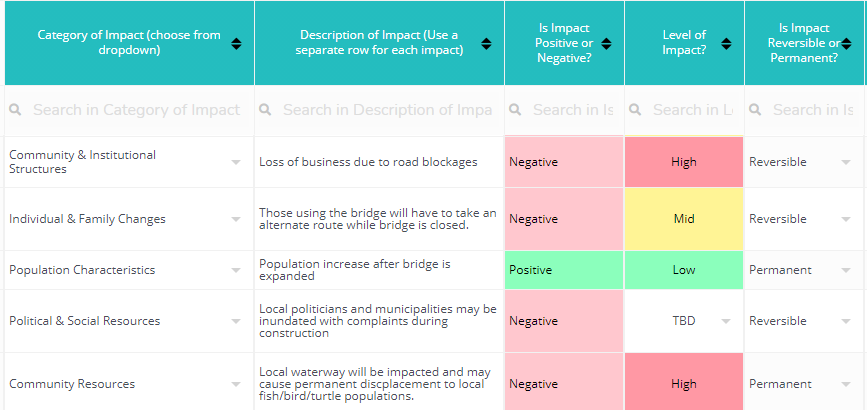
Example of social impact assessment inputs using AGS’ Social Impact Assessment Template
What does social impact mean when it comes to a socio-economic impact assessment? It means evaluating all the different ways – both positive and negative – that a new intervention will affect humans and their environment.
The social impact assessment report attempts to identify all potential social impacts of a project or policy and ways to mitigate negative outcomes.
What Are Examples of Social Impacts?
Because there are so many different types of social and economic impacts that could be caused by a project, policy, plan, or program, impacts are usually put into five key categories when doing a social impact analysis.
The categories help when creating social impact assessment reports because they separate the types of impacts that may need to be addressed into different groups. For example, one group might reflect political impacts, and another may include individual and family impacts.
When creating a social impact assessment PPT questionnaire to gather data for a social impact evaluation, it’s a good idea to put impacts into these categories to make them easier to manage.
SIA Social Impact Assessment Impact Categories:
- Community and institutional structures
- Population characteristics
- Political and social resources
- Individual and family changes
- Community resources
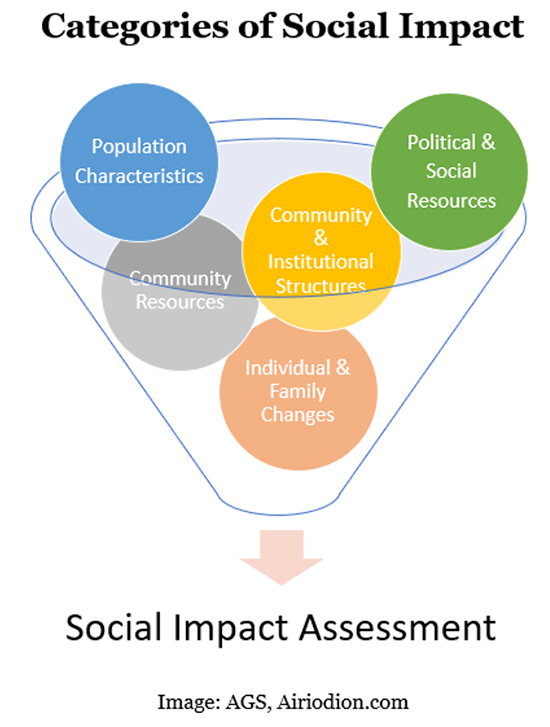
You can find social impact examples below for each category.
Community and Institutional Structures
This category in a social impact assessment example includes things such as industrial diversification in an area, the level of organization of a local government, the activity of nonprofit organizations, religious organizations, political structures, and how different community organizations relate to each other.
An example of impacts in this category that you might put into a social impact study for a proposed new community nonprofit grant program would be:
- Nonprofits would have the capital to do more for their community mission
- Local banks may suffer from fewer nonprofit loan clients
- The government would have a closer partnership with local nonprofits
Population Characteristics
This category of an ESIA environmental social impact assessment includes impacts to the present population numbers, ethnic or racial diversity, and any changes to seasonal or temporary residents.
This social impact assessment definition is one of the most clear-cut. An example of this category of social impact would be if a large bridge project was going to decrease the seasonal resident population during construction, but potentially increase it after the project was completed.
Political and Social Resources
When creating an environmental and social impact assessment PPT questionnaire, this category of impact relates to the power authority in an area and distribution of power. This would include leadership capability and leadership capacity, as well as relationships between power authorities and people.
Using methods of environmental and social impact assessment, it can be estimated how a particular policy might upset or enhance the current political or community leadership in an area.
An example would be a new dam project that brought jobs to a community that then enhances how citizens view the leaders in power.
Individual and Family Changes
Individual and family changes include impacts on the daily life of the people in the area being assessed. This category can include a wide variety of different impacts such as:
- Attitudes
- Perceptions
- Family characteristics
- Friendship networks
- Health & safety
- Risk perception
- Employment
- Conveniences
If a large chemical plant were being prosed in a town, then the perception that the plant would cause harm to health and safety would be a potential social impact in this category. A positive impact could be that it generated new jobs, thus boosting hope for a brighter future in the region.
Community Resources
As we noted, the definition of social impact assessment often includes the environmental assessment. This is the category to put any environmental impacts of a project.
Community resources include several types of impacts, such as:
- Natural resource and land use
- Availability of housing
- Availability of community services (police, fire, sanitation, health, etc.)
- Cultural and historical resources
Social impact examples in this category would include a construction project that was adding 1,500 units of affordable housing. Another would be a land-use policy change that could cause harm to an animal population in the affected zone.
Don’t Miss: Best Guide for Conducting an Economic Impact Assessment
What is Environmental and Social Impact Assessment?
An environmental and social impact assessment looks at all the potential impacts that a policy change or new project, plan, or program will have on a defined community.
The social impact assessment process is a detailed one and it’s designed to inform the project/policy stakeholders about any potential positive and negative outcomes in the community as a result of their desired undertaking.
There are multiple steps of social impact assessment, it’s not something that is just finished once a social impacts assessment report is handed over.
Those performing social impact assessments will use social impact assessment tools that allow them to do three important activities. These include:
- Analyze
- Monitor
- Manage
Analyze
The initial phase that lays the foundation to answer the question, “What is a social impact for this project?” is the analysis phase. This involves extensive analysis and data gathering to create a list of all potentially positive and negative project/policy effects.
During the analysis phase, a social impact assessment template will often be used as a way to catalog each type of impact, the impact category, and other information.
AGS Social Impact Assessment Toolkit
AGS Social Impact Assessment Toolkit Automates the Process of Impact Assessment
Data is collected from multiple sources during this phase of the socio-economic impact assessment. There is baseline data that’s needed, as well as a study of past similar projects and how those impacted a community.
A social impact assessment questionnaire may also be sent to stakeholders in the community to gather details on perceptions and feelings about the new policy or project.
Monitor
While the change is being made (e.g. during the construction phase of a building project) as well as afterward, an important part of the social impact analysis is to monitor impacts.
Are the expected impacts noted in the social impact assessment report occurring as expected? Are there new unexpected impacts happening that need to be managed?
Monitoring ensures that the expectations laid out in impact assessment reports are unfolding as projected. It’s also designed to immediately alert project managers if there are unexpected effects from the policy/project so they can be addressed as soon as possible.
Manage
There are multiple moving parts to a new project or change, and one of those is continued management of economic and social impacts.
Social impact meaning when it comes to management includes staying on top of any unexpected impacts that were uncovered during monitoring and adjusting project parameters as needed.
A social impact assessment example of management includes being an informational resource for community leaders and other stakeholders. It can also include continuing to use a social impact questionnaire to “take the temperature” of community perceptions before, during, and after project/policy implementation.

Social Impact Assessment Definition
Related: Everything You Need for the Best Business Impact Assessments (BIA)
Why Are Social Impact Assessments Important?
What does social impact mean to a community? To the company that’s causing the impact? To the community leaders?
It can mean different things to different people, but the ultimate goal is to create the best outcome for a proposed new project or policy change.
It’s important to use a social impact assessment tool proactively to optimize the most positive project outcomes for communities, those that live in those communities, and other stakeholders
According to the International Association for Impact Assessment (IAIA), the purpose of a social impact evaluation is to “bring about a more ecologically, socio-culturally and economically sustainable and equitable environment.”
Without a full understanding of how a new project or policy may impact the surrounding community and environment, a government or organization may unintentionally cause harm to a community.
An environmental social impact assessment is one of the most important inputs for project stakeholders so they understand all aspects of an intervention’s impact, can propose alternatives if needed, and work with the community to reach the best and most equitable outcomes for everyone.
Methods of Environmental and Social Impact Assessment
We’re going to discuss two methods of environmental and social impact assessment that are used for EIA SIA reporting.
One is the comparative SIA method, which is a way to gather the most accurate data about a proposed project or change in policy. It’s designed to help with understanding the probable effects of an intervention.
Another method used when doing a social impact study is related to organizing data by both impact category and the development stage of the project/policy. This type of social risk assessment template helps in estimating at which stage in a project an anticipated impact will occur.
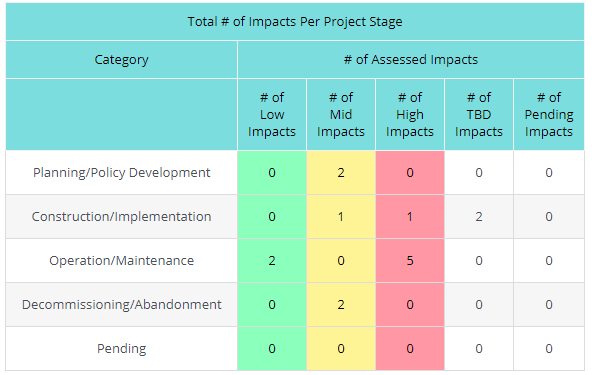
Using an automated reporting dashboard in a Social Assessment Tool can save you time.
Comparative SIA Method
When you are doing an SIA social impact assessment related to an environmental change that is new to a particular community, one way to estimate potential positive and negative impacts is to look at another community where that same change has occurred.
For example, if “Community A” had a new highway constructed a few years ago, you can look at the social impact of road construction for “Community A” and extrapolate that analysis, adjusting variables as needed, for “Community B,” a community that has never had a highway project.
In an ESIA environmental social impact assessment, the comparative SIA method can provide some of the best data because the analysis has the benefit of knowing what unforeseen impacts may have happened to the community following the project or policy change.
EIA and SIA Social Impact Assessment Template
The social impact assessment process can become complex because there are so many different data points that need to be brought together into a cohesive social impacts assessment report. It helps to create an assessment matrix to cross-reference assessment variables.
The two sets of information to use in the social impact assessments matrix are:
- Impact categories
- Project/policy development stage
The impact categories are:
- Community and institutional structures
- Population characteristics
- Political and social resources
- Individual and family changes
- Community resources
The project/policy development stages are:
- Planning/Policy Development
- Construction/Implementation
- Operation/Maintenance
- Decommissioning/Abandonment
Since we have not touched on these project/policy development stages yet in the definition of social impact assessment in our guide, we’ll explain.
There are four stages of a product or policy implementation lifecycle. In the planning/policy development stage, the change is being planned, proposals are being made to stakeholders, and the steps of social impact assessment begin.
The planning stage is followed by the construction or implementation of the project or policy, and then the continued operation and maintenance. Finally, a project may at some point in the future be decommissioned or abandoned. This stage is also pertinent when a policy is changed again in the future.
Using a social impact assessment tool or a spreadsheet that you create, cross-reference the types of impacts that can happen by impact category in each stage of the implementation of the project/policy.
Here is an example social risk assessment template that does this below:
Sample Project: Bridge Expansion
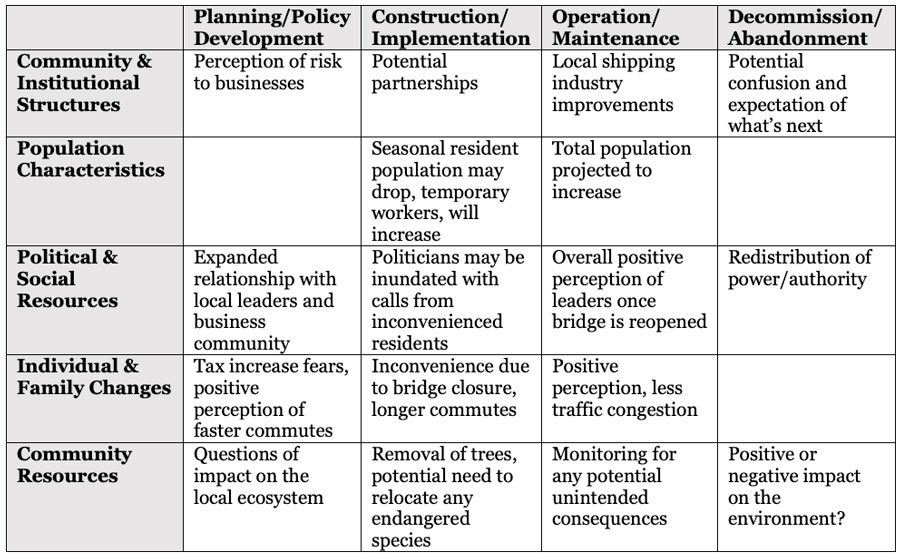
The Steps of Social Impact Assessment
Now that we’ve reviewed the types of data collected for social impact assessment reports, we’ll take a look at the process. There are several steps of social impact assessment taken to help reach the mission of creating a sustainable and equitable outcome for a project or policy change.
Many of these steps for an ESIA environmental social impact assessment overlap as you’re going through the process. They’re all important and can be guided by using social impact assessment tools designed to facilitate your information gathering and reporting.
1. Develop a Public Involvement Plan
Anyone that will be impacted by a new project or policy needs to be involved in the process. This ensures that all viewpoints about potential impacts are included in the social impacts assessment.
When you ask, “What is social impact?” or “What is a social impact from this project?”, you want the answer to be as complete as possible. If you don’t develop a public involvement plan as the first step of social impact assessments, you may end up with several critical consequences from project/policy impact that could’ve been avoided.
You’ll want to reach out and develop your plan for communicating with community members and the public at large. This can include:
- Local politicians
- Municipal organizations (police, social services, etc.)
- Nonprofit organizations
- Local community leaders
- Public hearings
Creating a public involvement plan provides you with open communication channels that you’ll use throughout the socio-economic impact assessment.
2. Describe the Proposed Project/Policy & Alternatives
Next, we’ll be giving a social impact definition as far as your project or policy change parameters. It’s important to detail all project requirements because this will help identify the types of data that you’ll need for the social impact analysis.
Using a social impact assessment example for a project expanding a bridge, some of the details you would include are:
- Project timeline
- Project location
- Human resources needed from the local workforce
- Materials needed
- Details of land requirements
- Size of the expanded area
- Municipal needs (roads, water lines, etc.)
- Details on approvals/permits needed
It’s also important to include any identified alternatives in social impact assessment reports. For example, if there is a new road that needs to be created to facilitate construction vehicles, but it’s found it may cause a traffic issue in a neighborhood, what location alternatives are there for that road?
It’s helpful to chart the project details and alternative details in an EIA SIA social impact assessment template that can be used for displaying meaningful analytics.
One way that your public involvement plan and this step can overlap is if you send a social impact assessment questionnaire or social impact assessment PDF for input to your identified community groups for advice on alternatives to include.
3. Describe the Baseline Conditions of the Human Environment
To do a proper social impact evaluation where you are accurately identifying potential impacts in a number of areas from a project or policy change, you need to know what the norm or baseline is.
Describe the current baseline conditions of the community and the human environment. You can add social impact meaning by including any seasonal baseline changes (population, employment, etc.) in the community, especially as they relate to the timeline and schedule of the project.
Baseline areas to consider for a social impacts assessment include:
- Environmental relationships
- Historical background
- Political and social resources
- Population characteristics
- Attitudes and culture
4. Identify Probable Social Impacts (Scoping)
The next environmental social impact assessment step is to identify all the probable social impacts of the policy change or project. You’ll want to use the social impact study matrix that we discussed earlier, where you cross-reference the categories of impacts with the stages of the project.
When working with an environmental and social impact assessment PPT or template, you want to not only include the social impacts that are probable but also include as many details as possible about each one. Such as:
- Is impact reversible or permanent?
- How probable is it that the impact will occur?
- How long will impacts be present?
- Number of people impacted
- Benefits or costs of the impact
- Controversy over issues (Is there any? How much?)
- Level of the unpredictability of subsequent impacts
Example of Social Impact Inputs in AGS’s Social Impact Assessment Tool
Learn More About AGS Impact Assessment Toolkits
5. Investigate Probable Impacts
Next, you’ll dig into the details of the probable social impacts you identified.
This part of the social impact assessment process requires understanding each probable impact in detail so you can suggest ways to mitigate any negative impacts and calculate the value of positive impacts.
You’ll want to gather data from a wide variety of resources, including the community leaders and contacts that you identified in the first step.
Other resources that you’ll need to identify probable social impacts include:
- Social science literature
- Past impact studies
- Comparative SIA analysis of a similar project in another region
- Public scoping and surveys
- Subject matter experts
- Census and statistical data
- Information from project proponents
- Field research
6. Anticipate Responses to Probable Impacts
How will residents that live and work in the affected area respond to the impacts? It’s important to anticipate all potential responses so adjustments can be made and concerns can be addressed as needed.
If a particular response is anticipated and identified in your social impact assessment definition, then proactive steps can be taken to mitigate negative reactions through communication and transparency.
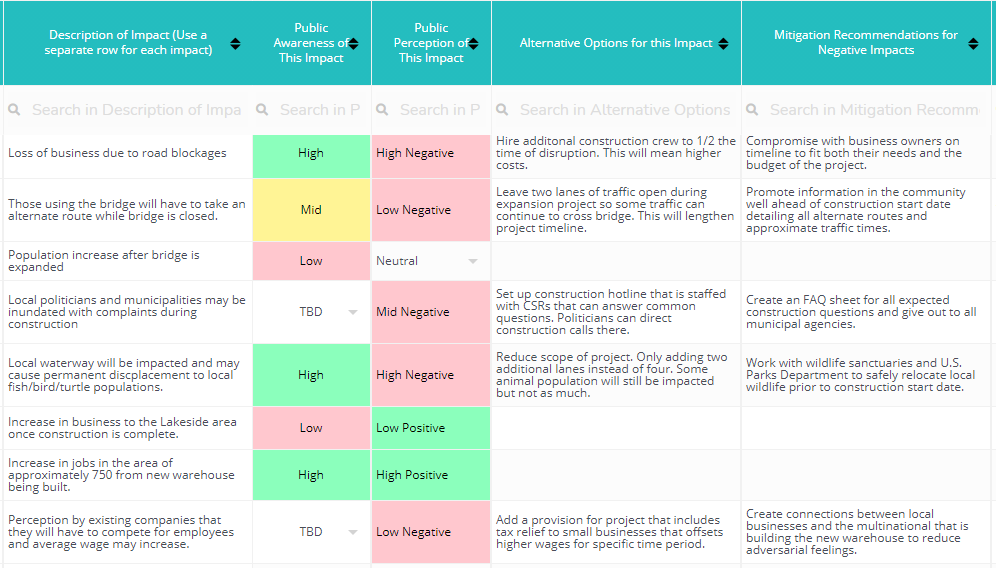
Example of inputs needed for a social impact analysis | AGS Social Impact Assessment Tool
7. Estimate Indirect and Cumulative Impacts
Other critical variables to include when using methods of environment and social impact assessment are the indirect and cumulative impacts that may occur as a result of the project/policy.
Indirect impacts will usually come later, after a direct impact. A cumulative impact is one that happens as a result of multiple impacts over time, which may be from other projects that have happened in the past.
For example, if one city area has seen several construction projects over a decade, it may lead to a cumulative impact of fewer businesses locating in the area due to the continuous traffic disruption.
Both indirect and cumulative impacts need to be included in your ESIA environmental social impact assessment.
8. Create a Mitigation Plan
Next, you’ll want to identify those direct, indirect, and cumulative impacts that have been noted in the EIA and SIA social impacts assessment that are negative.
For each negative impact, you should create a proposed mitigation plan to either prevent the negative impact or mitigate the severity as much as possible.
Those alternatives you identified earlier in the social impacts assessment process will factor in here as potential mitigation options.

What is a Social Impact? | Social Impact Assessments Monitoring
9. Develop a Monitoring Program
It’s important to monitor social impacts throughout the project, including the construction/implementation phase, and afterward.
The social impact meaning of the monitoring program is to ensure that projected impacts and mitigation strategies are not deviating from what is expected.
Monitoring is also needed to identify any impacts that have occurred that were not anticipated. Early identification is vital for mitigation efforts.
If there was some uncertainty about the potential for identified impacts to happen, a monitoring program is crucial. Monitoring programs may also themselves impact an area as an indirect impact.
Read More: Best Data Protection Impact Assessment
What is Social Impact Assessment UPSC?
When you’re researching social impacts, you may come across results for “social impact assessment UPSC.”
This refers to sample questions and answers related to social impact definition and process for the Civil Services Main Exam of India’s Union Public Service Commission (UPSC).
The Civil Services Exam is a nationwide examination in India used for recruitment for a variety of civil service positions. Because social impacts assessment is part of this exam, you’ll find Q&As online related to social impact assessment UPSC for those taking the exam to study.
Sample Questionnaire: Social Impact Assessment PPT & Social Impact Assessment PDF
As part of social impact assessments, questionnaires are typically sent out to various stakeholders, such as local business owners, members of the public, community leaders, and others.
A social impact assessment questionnaire will vary widely depending upon the project and policy change that is being made. However, there are certain goals that you have with this type of data collection that your questions will need to reflect.
These goals include:
- Get general population data
- Understand the typical day-to-day activities that a project might impact
- Gauge perceptions of the potential project impacts
- Gather data on project awareness
- Gain a perspective on which impacts may be viewed as more or less severe
It can help when shaping the questions for a social impact analysis to have a general template to go by for ideas. AGS has put together a social impact assessment PPT and social impact assessment PDF that you can use as a general questionnaire guide.
This template includes question types based upon the kind of data you need for a social impacts assessment as well as some tips on how to format questions.
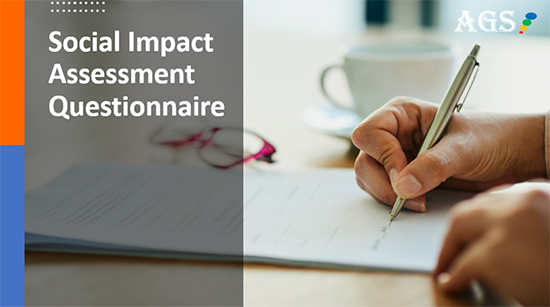
Download Questionnaire for Social Impact Assessment PPT
Download Questionnaire for Social Impact Assessment PDF
Best Social Impact Assessment Template
When trying to gauge impacts from a change, multiple data points are collected. Using social impact assessment tools and templates can give you a place to input your data and aggregate it into meaningful analytics.
Example Reporting from AGS’ Social Impact Assessment Toolkit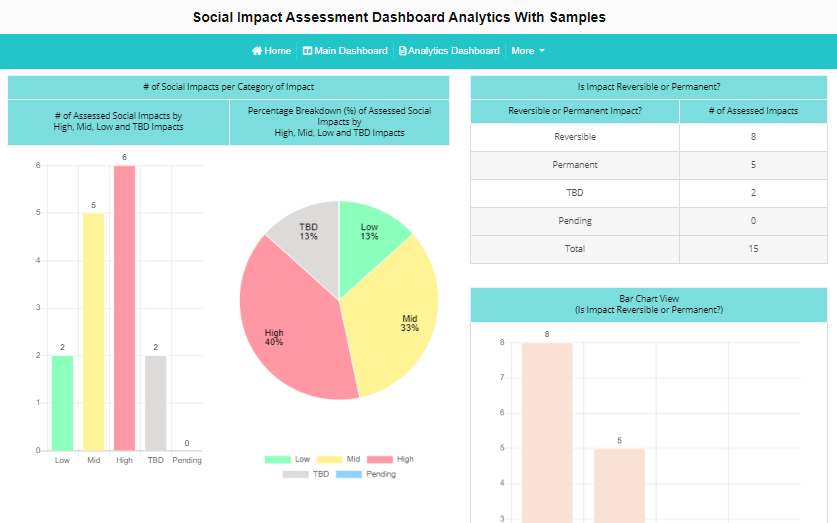
What is social impact reporting? It often involves using charts, bar graphs, and other analytics to present the data from a socio-economic impact assessment in a meaningful way.
Using the AGS Social Impact Assessment Toolkit saves you considerable time because all those analytics are created for you automatically. You don’t have to be an Excel expert!
AGS Social Impact Assessment Tool Features:
- A fully integrated database for input and analytics dashboard for reporting
- Input your data directly or upload it from a spreadsheet template
- Real-time collaboration with team members
- Use on any device
- Add your own columns to customize the template
Purchase AGS Best Social Impact Assessment Tool Now!
Conclusion | Best Social Impacts Assessment Guide
Anytime a new project, plan, program, or policy change is going to impact a group of people in a community, it’s important to undertake a social impacts assessment. This type of assessment and report gives the social impact meaning as far as the positive and negative effects on the community and individuals that live and work there.
Social impact assessment reports can shape project parameters to mitigate potentially damaging outcomes. Their goal is to ensure equity for all involved, foster positive impacts, and reduce negative ones.
The answer to “What is a social impact?” will vary from project to project, but the fundamentals of assessing impacts on humans and their environment remain the same. It’s a methodical process that’s very detailed and that’s also vital to the success of any major intervention in a community.
What is Social Impact?
A social impact is an effect on communities and people that can happen as the result of an intervention or non-intervention taken when implementing a policy, program, plan, or project.
What Are Examples of Social Impacts?
Social impacts can happen in a number of different areas, which is why social impact assessments will typically use categories to classify different types of social impacts.
Social impact categories:
• Community and institutional structures
• Population characteristics
• Political and social resources
• Individual and family changes
• Community resources
What is an Environmental and Social Impact Assessment?
An environmental and social impact assessment looks at all the potential impacts that a policy change or new project, plan, or program will have on a defined community.
The social impact assessment process is a detailed one and it’s designed to inform the project/policy stakeholders about any potential positive and negative outcomes in the community as a result of their desired undertaking.
Why are Social Impact Assessments Important?
It’s important to use a social impact assessment tool proactively to optimize the most positive project outcomes for communities, those that live in those communities, and other stakeholders
According to the International Association for Impact Assessment (IAIA), the purpose of a social impact evaluation is to “bring about a more ecologically, socio-culturally and economically sustainable and equitable environment.”
Without a full understanding of how a new project or policy may impact the surrounding community and environment, a government or organization may unintentionally cause harm to a community.
Note: Content on OCM Solution's ocmsolution.com website is protected by copyright. Should you have any questions or comments regarding this OCM Solution page, please reach out to Ogbe Airiodion (Change Management Lead) or the OCM Solution Team today. OCM Solution was previously known as Airiodion Global Services (AGS).
Images: https://unsplash.com/photos/W7j5IfmfIKo, https://www.pexels.com/photo/man-wearing-gray-dress-shirt-and-blue-jeans-3184317/, https://pixabay.com/photos/mount-polley-field-biologist-4770062/, https://www.ls.graphics/free/free-pixel-4-and-pixelbook-go-mockup

